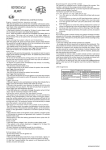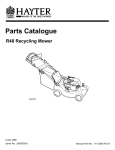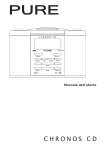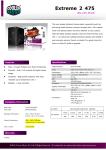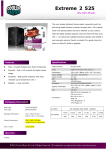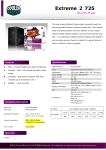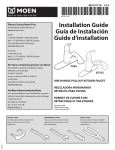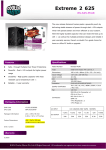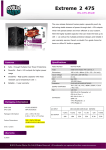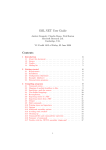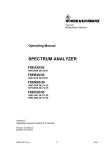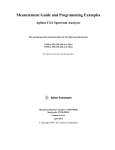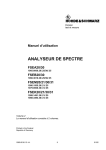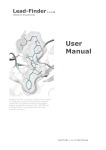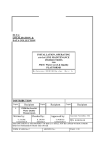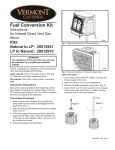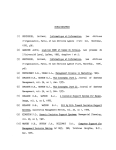Download Opening Persistent systems to the Internet 1 Introducing the YAT
Transcript
Opening Persistent systems to the Internet
RT3.2 Task Force
September 10, 1998
Through the World-Wide-Web (abbr. Web) service, everybody having an Internet connection
has now access to huge amount of data, structured through hyperlinks. However this mine of
data still lacks many features to make it a convenient repository. It lacks the features currently
available in PAS and notably high level languages for interrogation or updates.
Obviously, there is a need for the PAS and Web worlds to collaborate. Programmers developing
large PAS applications will want to utilize, in addition to the data stored in their system,
information available on the Web. Conversely, information stored in some PAS should be made
available to the Web users.
Our objectives are to make this collaboration possible. As a rst step, we have designed and
implemented a tool to allow the communication from/to a PAS to/from the Web. The prototype
is based on ideas discussed during the PASTEL worshops with the various partners of Task RT3.2
and has been developed at INRIA.
1 Introducing the YAT System
The number of intra/extra/internet applications integrating heterogeneous data is rapidly increasing. Central to these applications is the conversion of data from one format to another.
Yet, data conversion is usually done in an ad hoc manner, by developing non reusable softwares.
We believe that this problem requires a declarative approach and present the YAT system that
achieves this goal.
To illustrate the problem, consider the following application. A car dealer company wants to
build an intranet application. Among other things, the company stores informations about its
dealers in a relational system and descriptions of the cars it sells in SGML documents. The
idea is to integrate all information in an object PAS and to provide an HTML interface so that
employees can view it on the Web. Using the YAT system that has been developed at INRIA, see
Figure 1, the application programmer rst imports two generic programs providing an ODMG
view of relational and SGML data. Using the graphical interface, the programs are combined and
customized for this speci c application. Then, an ODMG to HTML program is imported and
customized in a similar way. If the application requires a di erent Web display of one particular
car or class of cars, the program can be further customized to provide di erent behaviours.
Finally, all programs can be type checked so as to verify their coherence and composed if the
required integration is virtual (i.e., the relational and SGML data are not migrated to the object
system).
YAT relies on a data model allowing a uniform representation of any data, a rule based language
and an instantiation mechanism allowing customization, type checking programs combination
and composition.
1
The Model: In a manner similar to, e.g., [PGMW95, BDS95, FFLS97, ACM97], we use a
simple representation of graphs to capture data coming from heterogeneous sources. The
YAT model is based on named ordered trees. Its main originality is its ability to capture various levels of representation. YAT can be instantiated into other models, either
ground (i.e., real data) or not (e.g., grammar/model, meta schema or schema). This
property o ers many advantages: it simpli es the speci cation and customization of conversion/integration programs, allows type checking to be turned on or o , programs to be
composed or combined in a coherent way.
The Language: YATL is rule-based. It features enhanced pattern matching facilities, powerful
restructuration primitives and, as in [Mai86, HY90, KKS92, PAGM96, FFLS97], explicit
skolem functions. Its main originality is its ability to preserve or reconstruct the order of a
collection and to perform grouping on collections featuring duplicates. Both these features
are needed by most standard formats (e.g., ODMG, HTML, SGML).
The Instantiation Mechanism: Instantiation of programs and models is the fundamental
characteristic of the YAT system. It provides the ability to re-use, type, combine or
compose programs.
No matter the user-friendliness of a language or graphical interface, most programmers do
not like to start from scratch. The common behaviour consists in fetching bits and pieces
of programs and to adapt them. With YAT, this is done automatically and in a coherent
way. The programmer starts with a general program that can be instantiated into one that
corresponds to the input data before being customized. For instance, through successive
instantiations/customizations, we may nd programs generating HTML pages from (i) any
input, (ii) ODMG compliant data, (iii) data corresponding to a speci c ODMG schema or
(iv) an object of that schema.
YAT provides exible typing. Programs signature are infered and can be checked against
any input or output formats. In this way, the programmer can verify, for instance, that the
output of a program is indeed an instance of the ODMG model or some ODMG schema.
Typing can be performed before or at run time.
By combination, one can easily write programs with heterogeneous inputs or that mix
general and speci c behaviours. This again relies on the instantiation mechanism that
allows to check the coherency of a combination of programs and, if needed, to order the
program rules in an appropriate manner.
If the output of a program is an instance of the input of another, they can be composed.
Program composition provides the means to avoid unecessary conversion into some intermediate formats. E.g., if we consider the example application, we can combine programs
so as to convert relational and SGML data directly into HTML.
The prototype: The YAT prototype implements all the features presented here. It is programmed in Objective CAML [], JAVA [] is used for the graphical interface. An on-line
demonstration is available1 .
There exist several data conversion/integration languages (e.g., [DH84, AH88, Kos96, ACM97,
PGMU96, PAGM96]) as well as many query languages for semi-structured data o ering similar
capabilities (e.g., []). However, none o ers the typing exibility of YAT or the ability to deal in
an appropriate manner with collections such as lists or bags.
Surf the YAT system homepage at http://www-rocq.inria.fr/verso/Jerome.Simeon/YAT/, for a description
of the system, up-to-date implementation status, and on-line demonstration.
1
2
OODBMS
RDBMS
YAT/relationnal
import/export
wrapper
YAT/ODMG
import/export
wrapper
(1)
YATL translation
rel+sgml −> odmg
YATL translation
odmg −> html
(2)
YAT/SGML
import/export
wrapper
YAT/HTML
import/export
wrapper
YAT patterns
(middleware)
SGML files
HTML files
Figure 1: Translation Scenario
The sequel of the paper is organized as follows. In Section 2, we introduce the model and instantiation mechanism. The language is presented through some examples in Section 3. Section 4
shows how one can use instantiation to customize, combine and compose programs. Section 5
presents the YAT prototype and Section 6 concludes the paper.
2 The YAT data model
Since we are interested in modeling data coming from arbitrary heterogeneous sources, we need
a exible representation model. The current trend in the literature on data integration is to
propose graph or tree models (e.g., [Abi97, BDS95, PGMW95, ACM97]). The main reason
for the popularity of this kind of model is its simplicity and the fact that one can easily map
anything into a tree/graph. Thus, and unsurprisingly, we propose yet another tree data model.
We represent data in a way that does not di er much from that of [ACM97].
Yet, there is a di erence. Whereas, previous work proposed models whose instances were data
trees/graphs, we propose a model that can be instantiated (or re ned) into another. This
property is the main originality of the YAT model, and we will see that it is indeed an essential
feature.
Let us illustrate this using the example scenario introduced in the previous section. We concentrate on the representation of ODMG data. A formal de nition of the model and the instantiation mechanism can be found in [CS97]. Figure 2 shows four models | two of which
incompletely drawn | that illustrate di erent levels of data representation. At the top left
side of the gure, the Yat model captures any data. On its right, a rst instance model of Yat
captures ODMG compliant data. The Car Schema model on the bottom left side is an instance
of both previous models and represents data that complies to a speci c ODMG schema. Finally,
the Golf model represents the actual database (we only represented the single object c1) and is
3
Pclass :
Yat:
L
L
&Yat
class
Class_name
*
*
Att
Yat
Ptype
Ptype :
Y : Int v String ...
tuple
*
Z: {set, list,
bag, array}
&Pclass
*
Att
Ptype
Ptype
The YAT model
Pcar :
The ODMG model
class
Psup :
c1:
class s1: ....
s2: ....
.........
car
car
&Pcar
name
desc
suppliers
S1: string
S2: string
set
name
"Golf"
desc
suppliers
"The 1995 Volkswagen
Golf GTI ..."
set
*
The Car Schema model
&s1
&Psup
&s2
The Golf GTI model
Figure 2: From General to Speci c
an instance of all its predecessors.
A Model consists of a set of patterns and their associated variables domains. We start by
de ning variables domains.
We use uppercase letters to denote variables. There exist two kinds of variables: (i) data
variables (e.g., L in YAT, Class name in ODMG, S 1 in Car Schema) and (ii) pattern
variables (e.g., Y at, Pclass, Pcar). We use bold fonts for patterns.
By default, the domain of a data variable is the set of all data constants and variable
names. For instance, the domain of the Yat variable L includes constants such as class,
car or \Golf" and variables such as Class name and Att. Note that constants can be
either symbols (e.g., class, name) or atomic data (e.g., "Golf", 1995). The default domain
can be restricted. For instance, consider the ODMG model and its Ptype pattern. The
domain of Y is de ned as the union of string, int, etc. Thus, a variable whose domain is
a string or an actual string like "Golf" are part of its domain.
The domain of a pattern variable is the set of all its instance patterns. In this example,
the domain of Y at includes c1 but also Pcar and Pclass.
A pattern represents a structure. It is identi ed by a name (that can be constant or
variable) and is de ned by a union of pattern trees. A pattern tree is an ordered tree
whose nodes are labeled with data variables or constants. Additionally, leaves may also
be labeled with pattern names (e.g., Y at, Ptype) or references to pattern names (e.g.,
&Y at, &Pclass, &s1). The former denotes dereferencing (i.e., a pattern name label will
be instantiated by a pattern tree), and is used to represent deeply recursive tree structures.
The latter resembles references to objects in a standard object model and allows sharing
and the management of cyclic structures (as in the Car Schema model).
4
The edges of a pattern tree are labeled with indicators of occurrences that are used in the
instantiation process. In the example, there are two such indicators: "?" which indicates
zero or more occurrences and the empty symbol which indicates exactly one occurrence.
A pattern whose value is not a union (i.e. is de ned by a single pattern tree), that does
not contain any variable and whose edges are all empty labeled is called a ground pattern.
E.g., c1 is a ground pattern but Y at is not. A ground pattern can only be instantiated by
itself. Ground patterns are used to represent real data, like in usual semistructured data
models.
Model Instantiation relies on pattern instantiation which itself relies on variable domain
inclusion. More precisely, (i) each pattern of the instance model must be an instance of some
pattern of the source model and (ii) a variable can be instantiated either by a constant belonging
to the variable's domain or by a variable whose domain is a subset.
Let us illustrate pattern instantiation by rst considering why Pclass is an instance of Y at.
We have explained variable instantiation. Edges instantiation relies on indicators of occurrence.
An empty labeled edge can only be replaced by a similar edge. A "?" labeled edge can be
replaced by any ordered sequence of edges, with or without label. Thus, assuming that Ptype
is an instance of Y at (which is indeed the case) and considering the rightmost argument of the
Yat union, we can see that the subtree whose root is Att is an instance of Y at. The same can
be said of the subtree whose root is Class name (we use pattern dereferencing here). Going up
one more step, we see that Pclass is indeed an instance of Y at.
Now, consider the Pclass and c1 patterns. The variable Class name has been instantiated by
the car symbol. The following "?" edge is instantiated by a sequence of empty labeled edges.
Consider the leftmost one. It goes to a node whose label name is an instance of the variable
Att. The next edge is correctly empty labeled and goes to the node labeled \Golf". "Golf" is
an instance of Ptype since it is a string and thus belongs to the domain of the Y variable.
To conclude this presentation of the model, let us point out the fact that there is a clear
analogy between the instantiation process and subtyping. Indeed, through instantiation (resp.
subtyping), we obtain patterns (resp. types) whose domains are more and more restricted.
Therefore, the YAT model combines some features of typed data models, with the exibility
required to manage heterogeneous data. This property of the YAT model can be used for various
purposes: to help the programmer write conversion programs or type them (see Section 3), to
customize, combine or compose programs (see Section 4).
Finally, we introduce the YAT syntax for patterns with an example. Patterns Pcar and Psup
from Figure 2 are given below. A labeled node is denoted by its label followed by the list of its
sons between brackets(h ... i), edges are denoted by arrows with their corresponding label. If a
node has a single son, brackets can be omitted.
Pattern for Car Objects
Pcar : class ! carh ! name ! S 1 : String;
! desc ! S 2 : String;
?
! suppliers ! set ! &Psup i
Pattern for Supplier Objects
5
Psup : class ! supplierh ! name ! S 1 : String;
! city ! S 2 : String;
! zip ! S 3 : String i
3 The YAT language
In this section, we present YATL, our language for the speci cation of data conversion. This language supports a graphical interface. Thus, programmers do not have to write YATL programs,
they are generated by the system given a graphical speci cation.
We introduce YATL basic features, demonstrate the language ability to handle heterogeneity
problems between data sources and present advanced YATL features to deal with collections.
Then, we address the problem of detecting cycles in a program. Finally, we show how YATL
programs can be type checked. A formal de nition can be found in [CS97].
3.1 Basic features
YATL is a rule-based language, each rule describing a part of the data conversion. A rule is
composed of a body and a head. The body contains patterns and boolean predicates whose roles
are to lter the input data, and external functions that compute additional data. The head of a
rule contains a single pattern which describes how the data which has been ltered in the body
must be re-structured.
Let us illustrate this with a rst program generating car and supplier objects from a set of SGML
brochures. The brochures comply to the following Document Type De nition (i.e. its grammar
or DTD) and give information about the cars, such as year of construction, technical description
and suppliers. The number element is distinct for each brochure, and the title element stores
the name of the car.
Brochures DTD
< ! DOCTYPE brochure [
< ! ELEMENT brochure - - (number, title,
<!
<!
<!
<!
<!
<!
<!
<!
ELEMENT
ELEMENT
ELEMENT
ELEMENT
ELEMENT
ELEMENT
ELEMENT
ELEMENT
number
title
model
desc
spplrs
supplier
name
address
---------
model, desc, spplrs) >
(#PCADATA) >
(#PCADATA) >
(#PCADATA) >
(#PCADATA) >
(sup) >
(name,address) >
(#PCADATA) >
(#PCADATA) > ] >
The rst rule of the program creates the supplier objects. Figure 3 illustrates sample input and
output for Rule 1.
6
Rule 1
Pbr :
brochureh ! number ! Num;
! title ! T;
class ! supplier
! model ! Y ear;
h ! name ! SN; (=
! desc ! D;
?
! city ! C;
! suppls ! supplier
! zip ! Z i
h ! name ! SN;
! address ! Addii;
Y ear > 1975,
C is city(Add),
Z is zip(Add)
Psup(SN ) :
Note that we have not given a domain to the various data variables used in the rule. This
means that they are associated to the default domain and can be instantiated by any constant.
The body of the rule is on the right-hand side of the (= symbol. It consists of (i) a pattern
representing the SGML brochures, (ii) one simple predicate which eliminates oldest cars and (iii)
two external functions which extract city and zip code from an input address. The head of the
rule consists of a single pattern whose name is parameterized by a variable (SN ) representing
the name of a supplier. Parameterized pattern names correspond to explicit skolem functions
as found in [KKS92, PAGM96, FFLS97]. Intuitively, the above skolem states that one object
will be created for each supplier name encountered in the input SGML brochures. Thus, if the
same supplier name appears twice in the input, only one object will be created.
This somehow implies that the name of a supplier represents its key. If it is not the case, the
result of transformation described by Rule 1 is non deterministic (e.g. if two suppliers share
the same name SN and not the same address, then YATL semantics do not specify the value
chosen for Psup(SN )). Syntactical restrictions can guarantee the determinism of a program.
However, this has a cost that the user may not want to pay (e.g., the ability to remove duplicate
values). In YAT, we accept potentially non-deterministic programs and alert the user at run
time when the same pattern name is associated to two distinct values.
Let us now use the above example to explain how rules are applied on input patterns b1, b2 from
Figure 3. The input of a rule is always a set of ground patterns (i.e., completely instantiated
patterns) which is processed in ve phases.
1. Each pattern in the input set is matched against the body of the rule thus forming the
following set of variable bindings.
f [ Pbr = b1; Num = 1; T = "Golf"; : : :; SN = "VW center"; Add = "Bd Lenoir ..." ]
[ Pbr = b2; Num = 2; T = "Golf"; : : :; SN = "VW2"; Add = "Bd Leblanc ..." ]
[ Pbr = b2; Num = 2; T = Golf"; : : : ; SN = "VW Center"; Add = "Bd Lenoir ..."] g
2. External functions are evaluated to generate new bindings. The rst element of the above
set then becomes:
[ Pbr = b1; Num = 1; T = "Golf"; : : :; Add = "Bd Lenoir ..."; C = \Paris"; Z =
75005 ]
External functions are typed. This means that a type lter is applied on the set of variable
bindings before they are evaluated.
3. Predicates are applied to lter the set of variable bindings. In our case, all bindings are
kept.
7
b1:
brochure
class
s1:
supplier
number
title
model
desc
1
"Golf"
1995
"The new
Golf GTI..."
spplrs
name
"VW
Center"
b2:
name
supplier
city
"VW
Center"
address
"Paris"
75005
"Bd Lenoir,
75005 Paris"
brochure
class
s2:
supplier
number
title
model
desc
2
"Golf"
1997
"The new
Golf GTI..."
spplrs
name
supplier
name
"VW2"
Input Brochures
zip
address
"Bd Leblanc,
78000
Versailles"
supplier
name
"VW
Center"
"VW2"
city
"Versailles"
zip
78000
address
"Bd Lenoir,
75005 Paris"
Output Suppliers
Figure 3: Applying Rule 1 on two SGML brochures
4. Skolem functions are evaluated. In this case, s1 is associated to Psup("VW center") and
s2 is associated to Psup("VW2"). Skolem functions are not dependent of a given rule
but are global to a program. In other words, the association between Psup("VW center")
and s1 can be recalled in another rule of the program.
5. Finally, the set of output patterns is constructed (in a straightforward manner as far as this
example is concerned) and each output pattern is associated to its name (see Figure 3).
Note that step 4 and 5 can be mixed since it is not necessary to evaluate all skolem functions
before computing the corresponding pattern tree. Let us now consider the second and last rule of
our program. It creates one car object for each brochure, each car referencing its set of suppliers.
Rule 2
Pbr :
brochure
h ! number ! Num;
class ! car
! title ! T;
h ! name ! T;
(=
! model ! Y ear;
! desc ! D;
! desc ! D;
?
! suppliers
! suppls ! supplier
fg
! set ! &Psup(SN )i
h ! name ! SN;
! address ! Addii
Pcar(Pbr) :
The creation of links from cars to suppliers is handled by the use of the parameterized pattern
name Psup(SN ). Because skolem functions are global to a program and can be processed
independently from their values, Rule 1 and Rule 2 can be applied in any order. So, it is not
necessary to use strati cation mechanism to preserve YATL declarativity. Note that we use
here the & symbol to denote a reference to a supplier. In other words, the corresponding leaves
in the output pattern tree will point to a supplier pattern tree (e.g., &s1). Omitting the &
8
symbol entails a dereferenciation, e.g., s1 would be replaced by its associated tree. Remark that
it requires that the value associated to s1 exists. Therefore, dereferenciation is handled at the
end of rules processing.
Note the use of symbol fg in the above rule's head. This annotation is used to create a node
(here, the node set) with several sons, all distinct and in no speci ed order. In the above rule,
node set will aggregate all the references to the suppliers of a given car.
Let us now see how cyclic references are managed in YATL. For this, we rede ne the way
suppliers are created. Rule 1 shows how cars can be associated to their suppliers.
0
Rule 1
0
Pbr :
brochure
h ! number ! Num;
class ! supplier
! title ! T;
h ! name ! SN;
! model ! Y ear;
! city ! C;
(=
! desc ! D;
?
! zip ! Z;
! suppls ! supplier
! sells
h ! name ! SN;
fg
! set ! &Pcar(Pbr )i
! address ! Addii;
C is city(Add),
Z is zip(Add)
Psup(SN ) :
Remember that the & symbol before a pattern name corresponds to a reference. Should we
remove the & symbol in both Rules 1 and 2, we would face a cyclic program. Detection of
cyclic programs is addressed in Section 3.4.
0
3.2 Dealing with heterogeneity
To illustrate YATL's ability to handle heterogeneity between multiple data sources, we propose
to write a rule taking its data from two distinct sources: a relational database whose schema is
given below and the above SGML documents.
Suppliers Relational Database Schema
suppliers[sid: integer, name: string, city: string,
address: string, tel: string]
cars[cid: integer, broch num: string]
sales[sid : integer, cid: integer, year: integer, sold: integer]
Rule 3 creates one car object for each distinct car in the relational database if it corresponds to a
brochure. Note that the SN variable is used in both body patterns to indicate that the supplier
name in the relational database and in the SGML documents should be the same. The external
function 'sameaddress' takes care of the heterogeneity between addresses in the database and in
the SGML documents.
9
Rule 3
Pbr :
Pcar(Cid) :
class ! car
h ! name ! T;
! desc ! D;
! suppliers
?
! set ! &Psup(Sid)i
brochure
h ! number ! Num;
! title ! T;
! model ! Y ear;
! desc ! D;
?
! suppls ! supplier
(=
h ! name ! SN;
! address ! Addii;
Rsuppliers
:
?
suppliers ! row
h ! sid ! Sid;
! name ! SN;
! city ! C;
! address ! Add2 ;
! tel ! Teli,
Rcars? :
cars ! row
h ! cid ! Cid
! broch num ! Numi,
sameaddress(Add; C; Add2 )
This rule shows how one can handle eventual inconsistencies in the data sources using the
YAT environment. Note that a similar approach to handle heterogeneity has been followed
in [ACM97, PGMU96, PAGM96].
3.3 Dealing with collections
Like other languages for data conversion/integration, YATL handles sets. However, an original
feature of the language is that, due to its data model and its active domain semantics (as opposed
to x-point), it is also well adapted to the manipulation of collections such as multi-sets and
lists. YATL provides one primitive for grouping and another for ordering. These two simple
features are sucient to deal appropriately with collections. We illustrate this point with two
examples.
Rule 4 creates an ODMG list of supplier objects (as created by Rule 1') ordered by their name.
For this it uses a primitive that combines both grouping (to remove duplicates) and ordering
on a given criterion. This requires that the set of variable bindings be processed (in that case
grouped and ordered) before the actual construction of the corresponding edges. In the example,
the criterion is a single variable. More variables can be used. Also, one can perform grouping
on some criteria and ordering on some others.
Rule 4
10
mat:
paris
caen
nice
Polo
Golf
Polo
Golf
Polo
Golf
100
110
20
22
300
330
Input Matrix
sales
mat’:
sales
Polo
paris
nice
100
Golf
caen
20
300
paris
nice
110
22
caen
330
Output Transposed Matrix
Figure 4: Transposing a 3 2 Matrix
Pbr :
brochure
h ! number ! Num;
Pallsups() :
! title ! T;
[]SN
list ! &Psup(SN ) (=
! model ! Y ear;
! desc ! D;
?
! suppls ! supplier
h ! name ! SN;
! address ! Addii
The possibility to handle ordered collections is important for various application domains. Ordered collections exist in many standard data models, and are essential to deal with documents.
The above example was rather database oriented. The YATL language is also able to manipulate
arrays, which are the subject of increasing interest [FM95, LMW96, MS97]. This is illustrated
by the following rule that transposes any input matrix. Note the use of the index edges I and
J to store the information about the original ordering of the sons.
Rule 5
New(Id) :
[]J
Id :
[]I
J
Mat ! Y ! X ! A (= Mat !I X !
Y !A
Figure 4 illustrates the application of Rule 5 on a matrix containing statistics on car sales.
3.4 Detecting cyclic programs
Remember our comment about the program presented in Section 3.1 which consisted of Rules 1'
and 2: if we remove the & symbol in both rules we potentially introduce a cycle in the program.
Indeed, let us consider a car c1 and a supplier s1 referencing each other. By removing the &
symbol, we break the referencing mechanism and require that the s1 tree includes the c1 tree
which itself should include the c1 tree, etc.
The bad news is that the general problem of statically detecting cycles in a YATL program is
undecidable (it is similar to nding wrong recursive calls in a programming language). However,
11
we may detect possibly cyclic programs and forbid their use. One simple way to do that is to
construct the dependency graph of dereferenced Skolems. If this graph is cyclic, it implies a
potential cycle in the program that is thus rejected. If we consider the above example, there
exists a cycle between the Psup and Pcar skolem functors.
However, this method has a serious drawback. It rejects conversion programs working by recursion on the input tree, programs commonly used for arbitrarily deep recursive structures.
Fortunately, this important class of programs features an interesting characteristic: they usually
rely on a skolem functor whose sole parameter is a pattern name and whose recursive invocation is always performed on a subtree of the input. This is further explained in the next
section. These recursive programs are called safe-recursive. This can be checked syntactically
and guarantees the absence of cycles at run time.
To summarize, we reject programs that are not safe-recursive and that feature a cycle in the
graph of dependencies of the dereferenciated Skolems.
3.5 Typing in YATL
To conclude this section, we brie y explain how typing can be performed in YATL.
A program takes a model as input and returns another model (see Section 2). Input and output
models can easily be inferred by considering the program (i) input and output patterns, (ii)
predicate/function signatures and (iii) variable domains.
For instance, consider the program consisting of Rule 1 and Rule 2. The input model of the
program consists of the single brochure pattern Pbr with restrictions on the type of variables
Add and Y ear. The type of Add is given by the signature of functions city and zip, that of
Y ear by the ">" predicate. The output model consists of two patterns Pcar and Psup and
restrictions on variables C , Z .
The couple of input/output models will be called the signature of a conversion program and
noted MIN 7! MOU T . Now, once the signature of a program has been inferred, this information
can be used in several ways.
It can be used to check if two programs can safely be composed or combined. This is explained
in the next section. It can also be used to check that the input (or output) model of a program
is indeed an instance of a more general model. For instance, the user may check that a program
generates car and supplier objects compliant with a given ODMG schema or, more generally,
with the ODMG model. Finally, by turning typing on at run time, we may verify that all
input data is involved in the conversion process. This is simply done by adding a rule such
as Rule Exception to the program. The rule should be applied only when another rule cannot
(see the following section to understand how this is possible). It features an empty head. Its
body contains one pattern that matches any input data and an external function that invokes
an exception.
Rule Exception
. (= Y at : P 2 : Y at,
E is exception()
12
It is important to understand that typing in YAT is in no way constraining. Programs do not
need it to be executed. If a part of the input data does not match the input model of a program,
no conversion will be performed on it, but no error will occur.
4 Customizing, combining and composing conversion programs
One of the most interesting feature of a YATL program is its ability to be "instantiated".
Program instantiation constitutes the basis of program customization. We show now how it
works using an example. We next show how programs can be combined so as to provide both
customized and general behaviors. Finally, we explain program composition.
4.1 Customizing programs
No matter the user-friendliness of a language or graphical interface, most programmers do not
like to start from scratch. The common behavior consists in fetching bits and pieces of programs and to adapt them. With YAT, the programmer starts with a general program that
can be instantiated into one that corresponds to its input data. Customization can follow.
For instance, through successive instantiations/customizations, we may nd programs generating HTML pages from (i) any input, (ii) ODMG compliant data, (iii) data corresponding to a
speci c ODMG schema or (iv) an object of that schema. Let us illustrate this with an example.
Below is a program that converts any ODMG data into HTML, thus allowing users of our
Intranet application to view data from a Web browser. The speci ed translation is that implemented by the O2 Web system [O2W96]. An object is converted into an HTML page (Rule
Web1), an atomic value into a string (Rule Web2), a collection or a tuple into a list of HTML
items (Rules Web3 to Web5) and an object reference to an HTML anchor (Rule Web6). The
rules bodies contain ODMG patterns, while rules heads contains HTML patterns as illustrated
in Figure 5. Four facts are noteworthy.
1. The program creates a new identi er for each HTML page through the HtmlPage skolem
function. It is the HTML wrapper's responsibility to map these pattern identi ers to a
real URL when creating the actual HTML pages.
2. The program uses recursive dereferenciation on skolem HtmlElement (in rules Web3,
Web4 and Web5), but is safe-recursive since the skolem parameter is a pattern name
(Ptype) and the recursive calls are performed on a subtree (P2 ).
3. Some edges are labeled with the ? symbol. This label provides implicit grouping as the fg
symbol but without duplicate elimination.
4. Finally, many variables are typed. For instance, X in Rule Web4 (resp. Web5) can only
be instantiated with the set or bag (resp. list or array) symbol. P2 in Rules Web3 to
Web6 can only be instantiated by a pattern name instance of Ptype.
Web1
13
HtmlPage :
html
head
HtmlElement:
h1
body
HtmlElement
*
title
ul
ol
*
*
*
*
li
li
HtmlElement
HtmlElement
String
HtmlElement
a
href
cont
URL
HtmlElement
String
HTML model (a subset of HTML 3.2)
Figure 5: HTML patterns
HtmlPage(Pclass) :
htmlh ! head ! title ! Classname,
! body h ! h1 ! Classname,
?
! ul ! li
h ! Att2;
(=
!
HtmlElement(Ptype)iii
Pclass :
class ! Classname !? Att ! Ptype,
Att2 is concat(Att; " : ")
Web2
HtmlElement(Ptype) : S (= Ptype : Data,
S is data to string(Data)
Web3
HtmlElement
(Ptype) :
?
ul ! lih ! Att2,
! HtmlElement(P2 : Ptype)i
(=
Ptype? :
tuple ! Att ! P2 : Ptype
Att2 is concat(Att; " : ")
Web4
HtmlElement
(Ptype) :
ul !? li ! HtmlElement(P2 : Ptype)i
(=
Ptype : ?
X : fset; bagg ! P2 : Ptype
14
Web5
HtmlElement(Ptype) :
ol o!I li ! HtmlElement(P2 : Ptype)i
(=
Ptype :
X : flist; arrayg !I P2 : Ptype
( )
Web6
HtmlElement(Ptype) :
ah ! href ! &HtmlPage(Pclass);
! cont ! Classnamei
(=
Ptype : &Pclass,
Pclass :
class ! Classname ! P2 : Ptype
Now, let us suppose that we want to display objects of the class car in a di erent way and
the Golf GTI object in yet another way. Using a tool such as O2 Web, this would entail writing
appropriate methods from scratch using C++ or some other O2 supported programming language. With YAT, the user instantiates the general program by giving a more speci c pattern.
This instantiation process is done automatically, and the resulting new program is equivalent to
the previous one, but more speci c. This program can then be customized accordingly to the
programmer's needs. Let us illustrate this by instantiating the Web program through the Pcar
pattern introduced in Section 3 (see Rule 2). Instantiation results in the following Rule.
rule WebCar
15
HtmlPage(Pcar) :
html
h ! head ! title ! car;
! body h ! h1 ! car;
! ulh ! lih ! "name : ";
! T 1i;
! lih ! "age : ";
! D1i;
! lih ! "suppliers : ";
?
! ul ! li ! a
h ! href !
(
! cont ! Classnameiiiii
(=
&HtmlPage Psup);
Pcar :
class ! car
h ! name ! T;
! desc ! D;
?
! suppliers ! set ! &Psupi;
Psup :
class ! Classname ! P2 : Ptype;
T 1 is data to string(T ),
D1 is data to string(D)
The body of the rule contains two function calls and two patterns: one is the given Pcar pattern,
the other one is an incomplete Psup pattern2 which has been obtained through instantiation of
rule Web6. It speci es that pattern name Psup can only be instantiated by an object belonging
to some class.
Let us see how Rule WebCar has been derived. Four rules have been used: Rule Web1 on the
upper part of the car pattern, Rule Web2 on the two subtrees associated to properties name
and desc, Rule Web4 on the subtree associated to the supplier property and Rule Web6 on the
leaf containing a reference to Psup. Then, output trees have been generated and, due to the
dereferenciation, have been appended together to form the head part of the rule. One exception
is the pattern that matched the &Psup leaf. Since it has not been dereferenced, it has been
added to the rule body along with all encountered function calls. Remark that two calls to the
'data to string' external functions are derived from rule Web2 and therefore, the system must
provide appropriate renaming of variables (here to T 1 and D1) to avoid con icts.
Once derived, the new rule can be rewritten to provide a customized presentation for car objects.
For instance, if we do not want to display the supplier of a car, we can rewrite Rule WebCar in
the following way:
rule newWebCar
Since we only give the P car pattern for the instantiation, the system does not assume any knowledge of the
P sup pattern referenced in P car.
2
16
HtmlPage(Pcar) :
Pcar :
html
h ! head ! title ! car;
class ! car
! body
h ! name ! T;
h ! h1 ! car;
(= ! desc ! D;
! ulh ! lih ! "name : ";
! suppliers
?
! T 1i;
! set !
i;
! lih ! "age : ";
T 1 is data to string(T ),
! D1iiii
D1 is data to string(D)
&Psup
4.2 Combining programs
Rule WebCar can be considered as the unique rule of a program translating car objects. Obviously, we would like to combine this program with the previous one so as to be able to convert
all objects into appropriate HTML pages. However, by doing this without caution we would
provide two translations for a given car object.
To solve this problem, YATL interpreter organizes the set of rules of a program hierarchically.
Thus, a program now consists of a set of rule hierarchies. For a given input pattern, the more
speci c rules (leaves in the hierarchy) matching the input are applied rst. If matching cannot
be obtained, less speci c rules in the hierarchy are tried and so on.
Rule hierarchies are built by the YATL interpreter according to possible rule con icts. A con ict
occurs only when: (i) there is a subtype relationship between two rules input models (as for
rules WebCar and Web1 in the above example), and (ii) the skolem functions used in these rules
are the same (e.g. there is no con ict for rules 1 and 2 de ned in Section 3 as they do not code
for the same set of output patterns).
Finally, the user may also enforce the rule hierarchy to apply some rules in a particular order,
according to the conversion he wants to achieve. For that purpose, YATL allows to enforce
a speci c hierarchy of rules. Of course, in this case, the declarativity of YATL programs is
transgressed. As was noted in the previous section, this ability to organize rules can be used to
check programs at run time.
4.3 Composing programs
Let us now explain program composition. Recall the example scenario and the program consisting of Rules 1 and 2 that created cars and suppliers from a given brochure. In order to
avoid unnecessary loading into the object database, the user may want to combine this program
with the above one that performs ODMG to HTML conversion. This would provide a direct
conversion from SGML documents to HTML.
A rst solution would be to apply successively the two programs. However, this would result
in unnecessary processing, since the system would create intermediate ODMG patterns. Using
YATL, it is possible to compose these two programs and generate a more ecient program.
Let us explain the principle of the composition mechanism. Taking two conversion programs
prg1 : M1 7! M2 whose input (resp. output) model is M1 (resp. M2 ) and prg2 : M2 7! M3,
the system rst check if prg1 and prg2 are compatible (i.e. if M2 is an instance of M2 ). If
this is the case, the system instantiates prg2 with the patterns of M2 . This produces a new
0
0
17
translation prg2 : M2 7! M3 . Then, the nal composition is straightforward as syntactically
identical patterns appear in the output model of prg1 and the input model of prg2 .
The signature of the two programs that we want to combine (SGML to ODMG and ODMG to
HTML) are compatible. Therefore, the ODMG to HTML translation can be instantiated on
Pcar and Psup patterns. It generates a rule WebCar (which only di ers from Rule WebCar
by having additional informations about pattern Psup) and another rule WebSup. Finally, the
program containing Rule 1 and Rule 2 is composed with this instantiated program. Two new
rules result from this composition. The rst, from the composition of Rule 1 and Rule WebSup,
creates HTML pages for the suppliers contained in our SGML brochures. The second, from the
composition of Rule 2 and Rule WebCar , generates HTML pages for the car descriptions. It is
given below.
0
0
0
0
0
Rule (2+Webcar )
0
HtmlPage(Pcar) :
html
h ! head ! title ! car;
! body h ! h1 ! car;
! ulh ! lih ! "name : ";
! T 1i;
! lih ! "age : ";
! D1i;
! lih ! "suppliers : ";
?
! ul ! li ! a
h ! href !
! cont ! supplieriiiii
(=
&HtmlPage(SN );
Pbr :
brochureh ! number ! Num;
! title ! T;
! model ! Y ear;
! desc ! D;
?
! suppls ! supplier
h ! name ! SN;
! address ! Addii;
T 1 is data to string(T ),
D1 is data to string(D)
5 Architecture and implementation
In this section, we brie y present the architecture of the YAT System as well as the current
status of the prototype.
5.1 Architecture
The YAT system provides a complete environment to design data conversion programs. It does
not provide the ability to query or update external sources. Still, we believe that it can serve as
18
Target1
export
wrapper
Specification Environment
Graphical User
Interface
Static
Typing
YATL program
instantiation module
Runtime Environment
YAT patterns/YATL rules Type
management module
checker
YATL
Interpreter
External Funtions &
Predicates evaluation
YAT patterns/YATL rules
management module
import
wrapper
Library of programs and models
Source1
import
wrapper
Source2
Figure 6: YAT System architecture
the basis for a mediator/wrapper system for data integration and are currently working in that
direction.
The heart of the system is composed of: (i) a module to manipulate YAT data and programs,
(ii) a module for type checking and type inference that can be called on demand and (iii) a
YATL interpreter.
Figure 6 describes the current architecture. There are three main parts : (i) the speci cation
environment, (ii) the run-time environment and (iii) a library of programs and formats. Both
environments rely on the "YAT model/YATL rules management module" for the internal representation and manipulation of patterns and rules. The speci cation environment provides (i)
a module to statically check/infer the type of a program and (ii) a graphical user interface to
specify translations, using (iii) program instantiation to customize existing programs if needed.
The execution environment uses wrappers to import (resp. export) data into (resp. from) YAT
and an interpreter to perform the translation. The interpreter relies on a separate module to
process external functions and predicates and, if required by the user, a type checker. The
library allows to save and import programs and models.
The runtime environment can be used independently or be linked to import/export wrappers to
generate stand-alone executables (e.g. like LATEX2HTML). In this case the translation system
connects to the import program to retrieve the input data whenever required. If the HTML
output wrapper is used, the generated executable can be used as a CGI script.
5.2 Prototype
The YAT system is implemented in the Verso Database Group at INRIA. It is written in Objective CAML [Ler97] and JAVA (for the graphical interface). It is now fully operational. It
provides all the above features as well as some export/import wrappers (HTML, O2 database
and XML) and appropriate conversion programs. Figures 7 and 8 show the YATL editor main
window with Rule 1 and the pattern editor. [Sma97] gives a complete description of this graphical interface.
We are currently enhancing this rst version of the prototype with new wrappers, and plan to
work on performance issues.
0
19
Figure 7: Rule 1 using YATL Editor
0
Figure 8: YATL Pattern Editor
20
6 Conclusion
So far, we have focused on data conversion. The next step would be to provide a system for
data integration, i.e., provide the means to queryexternal data as well as convert it.However,
some issues should be addressed to achieve this goal. Notably, we plan to work on the following
issues:
Design and implementation of a query language : YATL lacks essential features to be
an adequate query language. Notably, one should be able to formulate keyword queries.
Furthermore, we need to be able to translate queries from YAT to the sources that are
queried. This obviously requires smarter wrappers and mediator.
Management of persistency : Although the mediator can be viewed as a simple gateway, it
should be able to store some data so as to be able to answer fast to a query or to palliate
to source server crashes.
Incremental view maintainance : As soon as data is stored in the system, we must be able
to refresh it in an ecient way and when needed.
These three directions of research will be further investigate with the various partners of task
RT3.2.
References
[Abi97]
[ACM97]
[AH88]
[BDS95]
[CS97]
[DH84]
[FFLS97]
[FM95]
S. Abiteboul. Querying Semi-Structured Data. In Proceedings of International
Conference on Database Theory (ICDT), pages 1{18, Delphi, Greece, January 1997.
S. Abiteboul, S. Cluet, and T. Milo. Correspondence and translation for heterogeneous data. In Proceedings of International Conference on Database Theory
(ICDT), Delphi, Greece, January 1997.
S. Abiteboul and R. Hull. Restructuring hierarchical database objects. Theoretical
Computer Science, 62:3{38, 1988.
P. Buneman, S. B. Davidson, and D. Suciu. Programming constructs for unstructured data. In Proceedings of International Workshop on Database Programming
Languages, Gubbio, Italy, 1995.
S. Cluet and J. Simeon. Data integration based on data conversion and restructuring. Technical report, Verso database group - INRIA, October 1997.
http://www-rocq.inria.fr/verso/Jerome.Simeon/YAT/.
U. Dayal and H. Hwang. View de nition and generalisation for database integration
in multibase: A system for heterogeneous distributed databases. IEEE Transactions
on Software Engineering, 10(6):628{644, November 1984.
M. F. Fernandez, D. Florescu, A. Y. Levy, and D. Suciu. A query language for a
web-site management system. SIGMOD Record, 26(3):4{11, September 1997.
L. Fegaras and D. Maier. Towards an e ective calculus for object query languages.
In Proceedings of ACM SIGMOD Conference on Management of Data, pages 47{58,
San Jose, California, May 1995.
21
[HY90]
[KKS92]
[Kos96]
[Ler97]
[LMW96]
[Mai86]
[MS97]
[O2W96]
[PAGM96]
[PGMU96]
[PGMW95]
[Sma97]
R. Hull and M. Yoshikawa. Ilog: Declarative creation and manipulation of object
identi ers. In Proceedings of International Conference on Very Large Databases
(VLDB), pages 455{468, Brisbane, Australia, August 1990.
M. Kifer, W. Kim, and Y. Sagiv. Querying object-oriented databases. In Proceedings
of ACM SIGMOD Conference on Management of Data, pages 393{402, San Diego,
California, June 1992.
A. S. Kosky. Transforming Databases with Recursive Data Structures. PhD thesis,
University of Pennsylvania, 1996.
X. Leroy. The Objective Caml system release 1.07. INRIA, December 1997. Documentation and user's manual. ftp://ftp.inria.fr/lang/caml-light/.
L. Libkin, R. Machlin, and L. Wong. A query language for multidimensional arrays: Design, implementation, and optimization techniques. In Proceedings of ACM
SIGMOD Conference on Management of Data, pages 229{239, Montreal, Canada,
June 1996.
D. Maier. A logic for objects. In Workshop on Foundations of Deductive Databases
and Logic Programming, pages 6{26, Washington, D.C., August 1986.
A. P. Marathe and K. Salem. A language for manipulating arrays. In Proceedings of
International Conference on Very Large Databases (VLDB), pages 46{55, Athens,
Greece, August 1997.
O2 Technology, Versailles. The O2 Web Reference Manual version 4.6, September
1996.
Y. Papakonstantinou, S. Abiteboul, and H. Garcia-Molina. Object fusion in mediator systems. In Proceedings of International Conference on Very Large Databases
(VLDB), pages 413{424, Bombay, India, September 1996.
Y. Papakonstantinou, H. Garcia-Molina, and J. D. Ullman. Medmaker: A mediation
system based on declarative speci cations. In Proceedings of IEEE International
Conference on Data Engineering (ICDE), pages 132{141, New Orleans, Louisiana,
February 1996.
Y. Papakonstantinou, H. Garcia-Molina, and J. Widom. Object exchange across
heterogeneous information sources. In Proceedings of IEEE International Conference on Data Engineering (ICDE), pages 251{260, Taipei, Taiwan, March 1995.
K. Smaga. Interface graphique pour la traduction de donnees. Master's thesis,
Universite Paris VI-CNAM-ENST, September 1997.
22






















